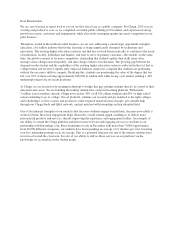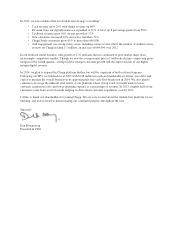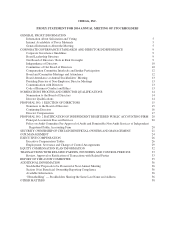Chegg 2013 Annual Report Download - page 3
Download and view the complete annual report
Please find page 3 of the 2013 Chegg annual report below. You can navigate through the pages in the report by either clicking on the pages listed below, or by using the keyword search tool below to find specific information within the annual report.Dear Shareholders:
We are very honored to report back to you on our first fiscal year as a public company. For Chegg, 2013 was an
exciting and productive year, as we completed our initial public offering in November, and experienced strong
growth in revenue, customers and engagement, while effectively managing against increased competition in our
print business.
Though we started in the textbook rental business, we are now addressing a much larger opportunity in higher
education, a $1 trillion industry that for the first time is being significantly disrupted by technology and
innovation. The existing higher education system is one that has evolved bureaucratically to conform to the needs
of institutions, faculty, publishers and funders, and fails to serve its primary customer—the student. At the same
time, the global economy is far more competitive, demanding that students update their skills more often,
manage career-change more frequently, and take charge of their own education. The growing gap between the
demands on the student and the capabilities of the existing higher education system is reflected in the fact that as
college tuition and fees have significantly outpaced inflation, employers complain that students are graduating
without the necessary skills to compete. Realizing this, students are questioning the value of the degree that has
left over 70% of them carrying approximately $30,000 in student debt while facing a job market yielding a 44%
underemployment rate for recent graduates.
At Chegg, we are focused on leveraging technology to bridge this gap, putting students directly in control of their
education and career. We are building the leading student-first connected learning platform. With nearly
7 million active members already, Chegg now reaches 30% of all US college students and 40% of high school
seniors intending to go to college. On our platform, students can research and get matched to the right colleges
and scholarships, review courses and professors, order required materials more cheaply, get valuable help
through our Chegg Study and Q&A network, and get matched with internships in their intended field.
One of the inherent strengths of our model is that the more students engage our platform, the more powerfully it
works for them. Increased engagement helps inform the overall student-graph, enabling us to deliver more
personalized products and services, thereby improving the experience and engagement further. An example of
our ability to extend the Chegg platform and deliver more relevant and engaging services to students is our
partnership with Internships.com. Since launching at scale in December with more than 70,000 opportunities
from 40,000 different companies, our students have been spending an average of 11 minutes per visit, browsing
over five internship postings each, on average. This is a powerful indicator not just of the interest students have
in services beyond the classroom, but also of our ability to deliver those services on our platform via the
knowledge we accumulate in the student graph.
















